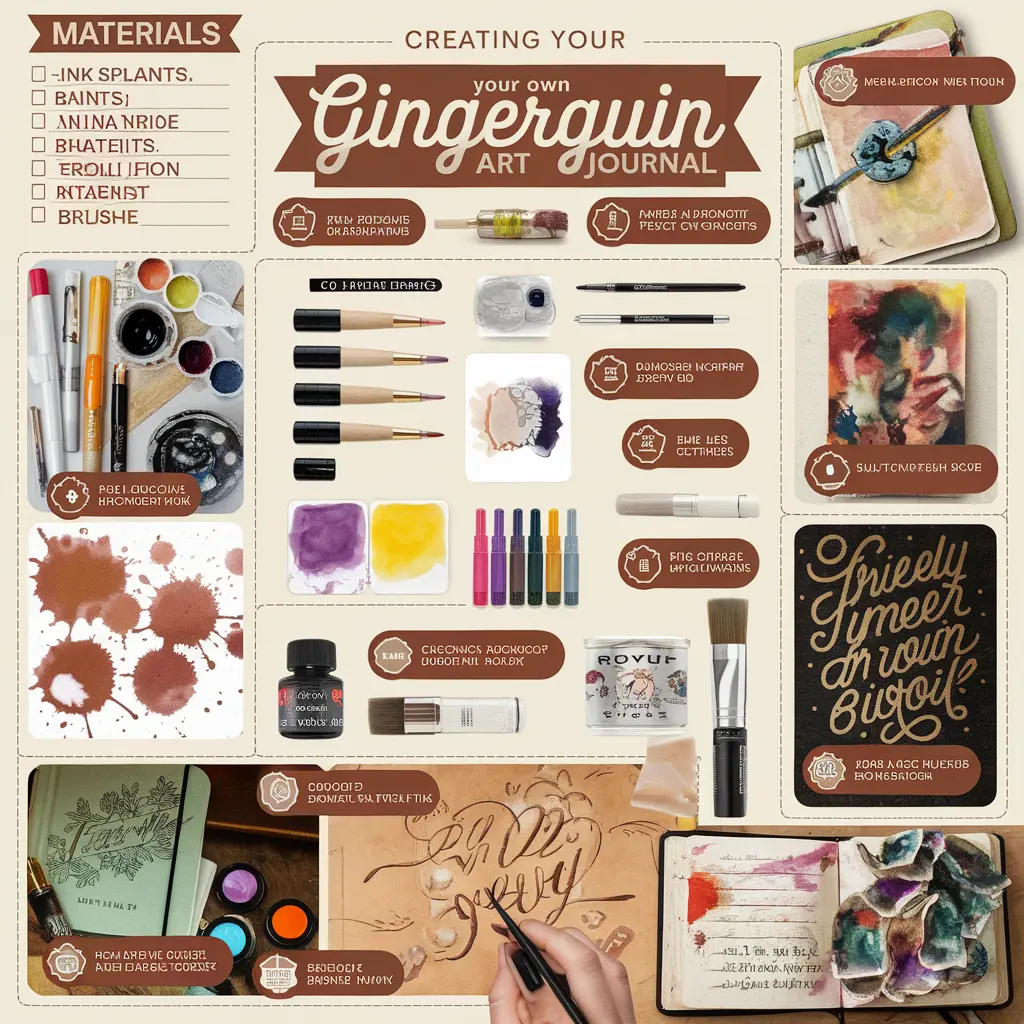Introduction
Creating a Gingerquin-inspired old art journal is an exciting journey for any artist or journal enthusiast. This project combines creativity, nostalgia, and a love for vintage aesthetics. A Gingerquin-style journal captures the timeless essence of art, blending antique touches with modern creativity. Whether you’re new to art journaling or have some experience, this step-by-step guide will help you craft a unique, personalized journal that feels like an artistic treasure.
This article provides a 2000-word guide to creating your own Gingerquin Old Art Journal, complete with detailed steps, tips, and inspiration. You’ll also find a cheat sheet at the end to help you quickly remember key points. So, gather your supplies, and let’s dive into the world of vintage art journaling.
Table of Contents
- What is a Gingerquin Old Art Journal?
- Gathering Your Supplies
- Creating the Journal Cover
- Preparing the Pages
- Adding Backgrounds and Layers
- Incorporating Vintage Elements
- Adding Personal Touches and Details
- Finishing Touches and Binding the Journal
- Cheat Sheet: Steps for a Gingerquin Old Art Journal
1. What is a Gingerquin Old Art Journal?
A Gingerquin Old Art Journal is an art journal inspired by the charm of antique design. It combines aged paper, vintage illustrations, and personal artistic expression. The “Gingerquin” style brings a warm, whimsical feel, often using earthy tones, botanical illustrations, and ornate borders. These journals look as though they’ve been touched by time, holding stories and memories within their pages. By creating one yourself, you craft a piece of art that feels both timeless and deeply personal.
2. Gathering Your Supplies
To start your Gingerquin art journal, you’ll need some essential materials. These tools allow you to create a truly vintage look:
Basic Supplies
- Blank Journal or Notebook: Choose one with sturdy, blank pages.
- Watercolor or Acrylic Paints: Earthy tones like brown, beige, and forest green work well.
- Brushes: Small to medium-sized brushes for painting details and backgrounds.
- Ink and Pens: Fine-tip pens in black or brown for sketches and calligraphy.
- Pencils: For light sketching and planning.
- Glue Stick and Double-Sided Tape: For securing decorative elements.
Decorative Elements
- Old Book Pages: Antique pages from discarded books add an authentic vintage feel.
- Stamps and Stencils: Floral and botanical designs work beautifully in this style.
- Vintage Ephemera: Use items like postcards, old letters, or vintage tickets.
- Dried Flowers or Leaves: Adds a botanical touch and enhances the vintage aesthetic.
- Tea Bags or Coffee Grounds: For staining paper and creating an aged look.
Gather everything in one place before you begin. This way, you’ll have easy access to all your tools while creating.
3. Creating the Journal Cover
The cover is the first thing anyone will see, so make it uniquely yours. Here’s how to create a Gingerquin-inspired cover:
- Step 1: Choose Your Base
Select a hardcover or cardboard base for a strong, sturdy cover. If you’re repurposing a book, make sure the cover is blank or easily paintable. - Step 2: Add a Layer of Paint
Choose a neutral or earthy color, like vintage brown or olive green. Apply one or two layers of paint with a wide brush to create a solid base. - Step 3: Distress the Cover
Use sandpaper to gently rub edges and create a worn look. You can also lightly rub coffee grounds on the surface for a weathered appearance. - Step 4: Decorate with Vintage Elements
Attach pieces of old paper, botanical illustrations, or even lace to the cover. Seal these pieces with a thin layer of glue or varnish for durability.
With the cover ready, let it dry completely before moving on.
4. Preparing the Pages
Now that your cover is complete, it’s time to prepare the pages. This stage is where your journal gains its aged and antique look.
- Step 1: Age the Pages
Use tea or coffee to stain each page, giving them a rich, brownish tint. Dab a sponge in your chosen liquid and lightly sweep it across the page. Let the pages dry flat to avoid curling. - Step 2: Add a Background Texture
Experiment with textured techniques, such as splattering paint or using a sponge to create uneven strokes. This adds depth to the pages and enhances the vintage feel. - Step 3: Stamp or Stencil Patterns
Lightly stamp botanical or lace patterns on the edges of each page. Choose soft, earthy colors to keep the vintage look consistent.
Prepping your pages gives them a handcrafted feel, making them look as though they’ve been touched by time.
5. Adding Backgrounds and Layers
Creating layered backgrounds brings a unique, rich look to each page. Follow these steps to build depth and detail:
- Step 1: Collage Old Book Pages
Tear pieces of old book pages or vintage ephemera, and glue them randomly across each page. This technique adds texture and a sense of history. - Step 2: Use Washi Tape and Lace
Place washi tape or strips of lace along the borders. This adds a delicate touch and frames the background layers. - Step 3: Paint Thin Layers of Color
Use a diluted paintbrush to apply soft layers of watercolor over the collaged areas. The translucent effect lets each layer show through, adding complexity.
These steps help set up a foundation that you’ll continue building on as you personalize each page.
6. Incorporating Vintage Elements
Adding vintage elements transforms your journal into a Gingerquin-inspired masterpiece. Here’s how:
- Step 1: Attach Ephemera
Use postcards, tickets, or photos from another era. Lightly distress the edges to blend them with the aged look of the pages. - Step 2: Press Dried Flowers and Leaves
Place dried botanicals in sections of the journal, securing them with glue or transparent tape. These natural elements tie into the botanical theme often found in Gingerquin art. - Step 3: Add Old-School Writing
Write quotes, poems, or your own thoughts in a vintage script style. Consider using a fountain pen or ink to mimic old-fashioned handwriting.
These elements enhance the story within your journal, inviting readers to experience the nostalgia in each entry.
7. Adding Personal Touches and Details
To make your journal truly your own, add personal touches that reflect your interests and personality:
- Step 1: Sketch Small Illustrations
Add simple sketches—perhaps leaves, animals, or symbols meaningful to you. Place them in margins or as focal points on certain pages. - Step 2: Write Meaningful Quotes
Choose quotes from classic books, famous poets, or your own writings. Place them strategically to inspire and captivate. - Step 3: Create Mini Pockets and Envelopes
Make tiny envelopes or pockets on some pages. Insert small notes, pressed flowers, or pictures, creating an interactive element in your journal.
These touches give your journal personality and make it a keepsake that truly reflects you.
8. Finishing Touches and Binding the Journal
When you finish decorating and personalizing each page, it’s time to finalize your journal:
- Step 1: Bind Loose Pages (If Needed)
If you used loose pages, bind them together. Use thread or ribbon to create a traditional, vintage-style binding. - Step 2: Add a Protective Layer
Apply a thin coat of Mod Podge or a similar sealant to each page. This will protect your artwork and give the journal a polished look. - Step 3: Attach a Bookmark
Tie a ribbon to the spine, creating a built-in bookmark. This is both practical and adds a stylish detail.
Now, your Gingerquin Old Art Journal is complete! Let it dry completely, and soon, you’ll have a vintage-inspired journal ready to fill with your art and thoughts.
Cheat Sheet: Steps for a Gingerquin Old Art Journal
| Step | Description |
|---|---|
| What is a Gingerquin Old Art Journal? | A journal style that captures vintage aesthetics and timeless art. |
| Gathering Supplies | Get a blank notebook, paints, ink, glue, vintage ephemera, and dried flowers. |
| Creating the Cover | Paint and distress the cover, then add vintage decorations. |
| Preparing Pages | Stain pages with tea or coffee for an antique look. |
| Adding Backgrounds | Layer backgrounds with old book pages, washi tape, and light watercolor. |
| Incorporating Vintage Elements | Add vintage ephemera, pressed botanicals, and handwritten text. |
| Personal Touches | Draw illustrations, write quotes, and add mini pockets. |
| Finishing Touches | Bind the pages, add a sealant, and attach a ribbon bookmark. |
Conclusion
Creating your own Gingerquin Old Art Journal is a rewarding, artistic journey that combines personal creativity with a love for vintage aesthetics. By following these steps, you’ll create a journal that feels timeless, meaningful, and uniquely yours. Whether you’re using it to record memories, sketch, or simply explore your artistic side, this journal will capture moments in a beautiful, nostalgic way.

